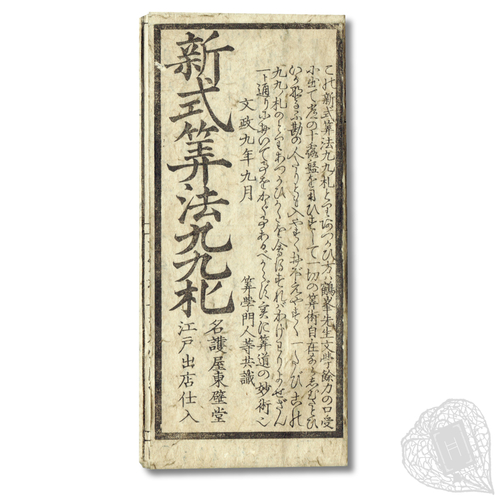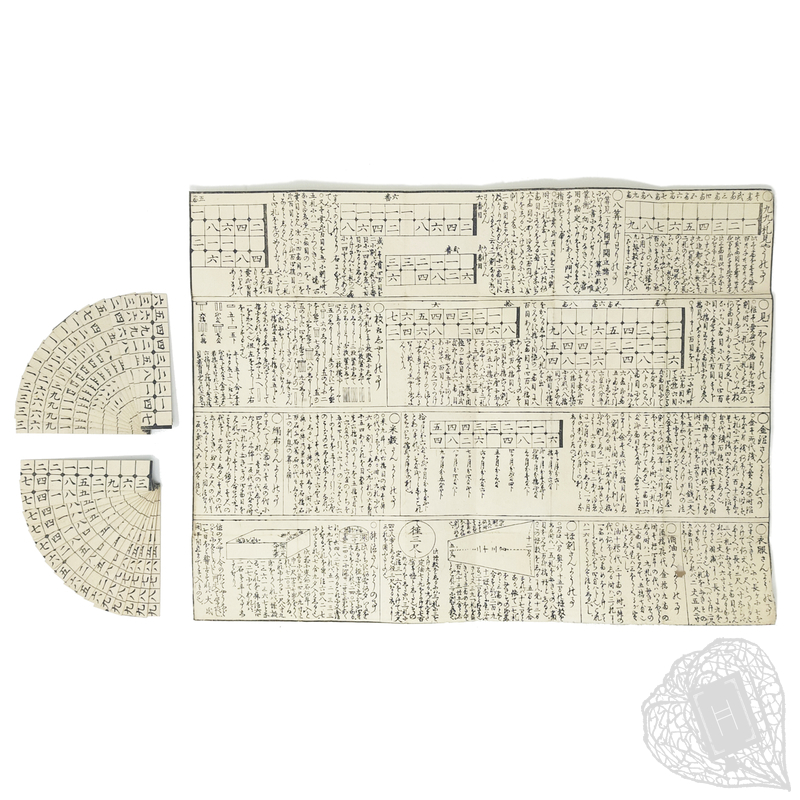Classic Illustrated Books Modern Art and Design Books Translations of Western Texts Japanese Literature Prints and Ephemera Western Books Photo Books Paintings & Scrolls Australia & New Zealand Others
Australia New Zealand Antarctica Japan Korea China Other
Edo Period [1603-1853] Bakumatsu Period [1853-1868] Meiji Period [1868-1912] Taishō Period [1912-1926] Shōwa Period [1926-1989]
Share this book on...

Shinshiki Sanpō: Kuku no Fuda (Nine-Nine Cards: A New Method of Arithmetic)
 ENQUIRE ENQUIRE |
Shinshiki Sanpō: Kuku no Fuda ["Nine-Nine Cards: A New Method of Arithmetic"]
[Tsurumine, Shigenobu (devised by)].
Nagoya: Tōhekidō, Bunsei 9 [1826].
A folded sheet of instructions for performing calculations using kuku ("nine-nine") cards, together with thirty cards. A relative of the Chinese multiplication table, this kuku method was created to help people do calculations without an abacus. The preamble on the outer panel of the leaf states that the method was first described orally by Tsurumine Shigenobu (1788–1858), implying that the creator of the leaf heard Shigenobu's description and transcribed (and printed) it, although it has been suggested that Shigenobu himself wrote the preamble under the guise of a "student of arithmetic". The leaf, which provides information on how to use the cards and how the method may be used by people of different professions (clothing sellers, rice sellers, fabric sellers, etc.), was originally published as a one-leaf print by Senraku (千輅), a resident of Edo, for Shigenobu. After the printing blocks were destroyed in a fire in the second month of Tenpo 5 (1834), Okumura Kisaburō reportedly commissioned new woodblocks and published a new edition of the same work. Tōhekidō, the publisher of the Bunsei 9 (1826) edition offered here, was probably Eirakuya Tōshirō (incidentally one of the publishers of Hokusai Manga). Shigenobu, the creator, dabbled in various scholarly fields including Dutch studies, geography, Shintō, physics, astronomy, and mathematics. No physical copies traced in OCLC or major Japanese library databases.
One fold-out leaf with thirty loose cards, presumed complete. Light wear to folding leaf, predominantly to exterior panels. Small hole to lower right section of leaf. 17.5 x 8 cm when folded; 31.4 x 41.8 cm when unfolded. Cards measure 2.3 x 9.9 cm each.
❧明治前日本数学史 第5巻, 1960, p. 444-445.
# 240518-1


• Ask a question about this item >
Classic Illustrated Books Modern Art and Design Books Translations of Western Texts Japanese Literature Prints and Ephemera Western Books Photo Books Paintings & Scrolls Australia & New Zealand Others
Australia New Zealand Antarctica Japan Korea China Other
Edo Period [1603-1853] Bakumatsu Period [1853-1868] Meiji Period [1868-1912] Taishō Period [1912-1926] Shōwa Period [1926-1989]
Share this book on...












